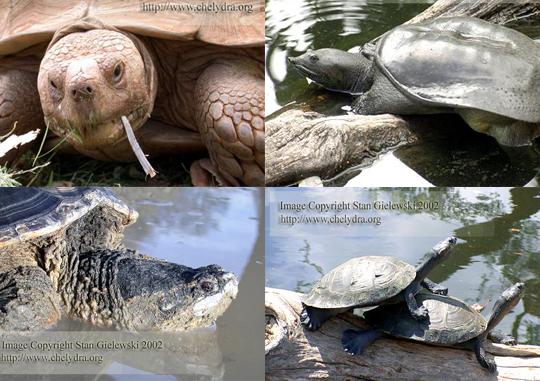Turtles are reptiles with a hard shell which encloses all of their internal organs.
They have been around on our planet since the Triassic Period - about 200 million years ago ( it makes them older than the great dinosaur groups ! ).

There are more than 250 species of turtles, the majority of which lives in tropical zones.
Turtles adjusted to living in all types of environments. Freshwater turtles can be found in ponds, lakes and rivers, marine turtles in the oceans and seas, and terrestrial turtles on land. There are also turtles that cross the borders between these environments, making them semiterrestrial.
Turtles come in a great variety of shapes and sizes. There are species only 6 inches ( 15 cm ) in diameter ( like for example the North American box turtle ), and the giant leatherback sea turtle, which may attain lengths of up to 8 ft ( 2.4 m ).
The upper shell of the turtle is called the carapace, and the lower is called the plastron , and due to adaptive changes and mode of life, their structure vary among different turtle species. Some of the aquatic turtle species, the soft-shelled turtles, have their carapace covered with leathery skin.
Turtles have no teeth but a horny sharp beak instead. They also lack a breastbone, and their heart has three chambers like the heart of other reptiles, except for crocodilians.
From an anatomical point of view, turtles and tortoises are divided into two basic groups:
- side-necked turtles - species that pull their heads into the shell by retracting their necks into an s-shaped curve
- arch-necked turtles - mainly freshwater species that hide their heads by bending the neck sideways
In English, the term tortoise refers only to terrestrial species, and all other members of the order are called turtles. The semi-terrestrial species are also called terrapines.
According to the Merriam Webster Dictionary, the word "turtle" is:
- Function: a noun
- Inflected Form(s): plural turtles also turtle
- Usage: often attributive
- Etymology: modification of French tortue, from Late Latin tartarucha,
feminine of tartaruchus of Tartarus, from Greek tartarouchos, from Tartaros Tartarus
- Date: 1657.
And for the "snapping turtle":
- Function: noun
- Main Entry: snapping turtle
- Date: 1784
>
'Snapping Turtle' in languages of the world:
English - snapping turtle
Polish - zolw jaszczurowy
Japanese - kami-tsuki game
'Turtle' in languages of the world:
English - turtle
Polish - zolw
Spanish - tortuga
Japanese - kame
Korean - chaara
Common & Latin names of variety of turtles:
English - Chelydra serpentina - snapping turtle
|